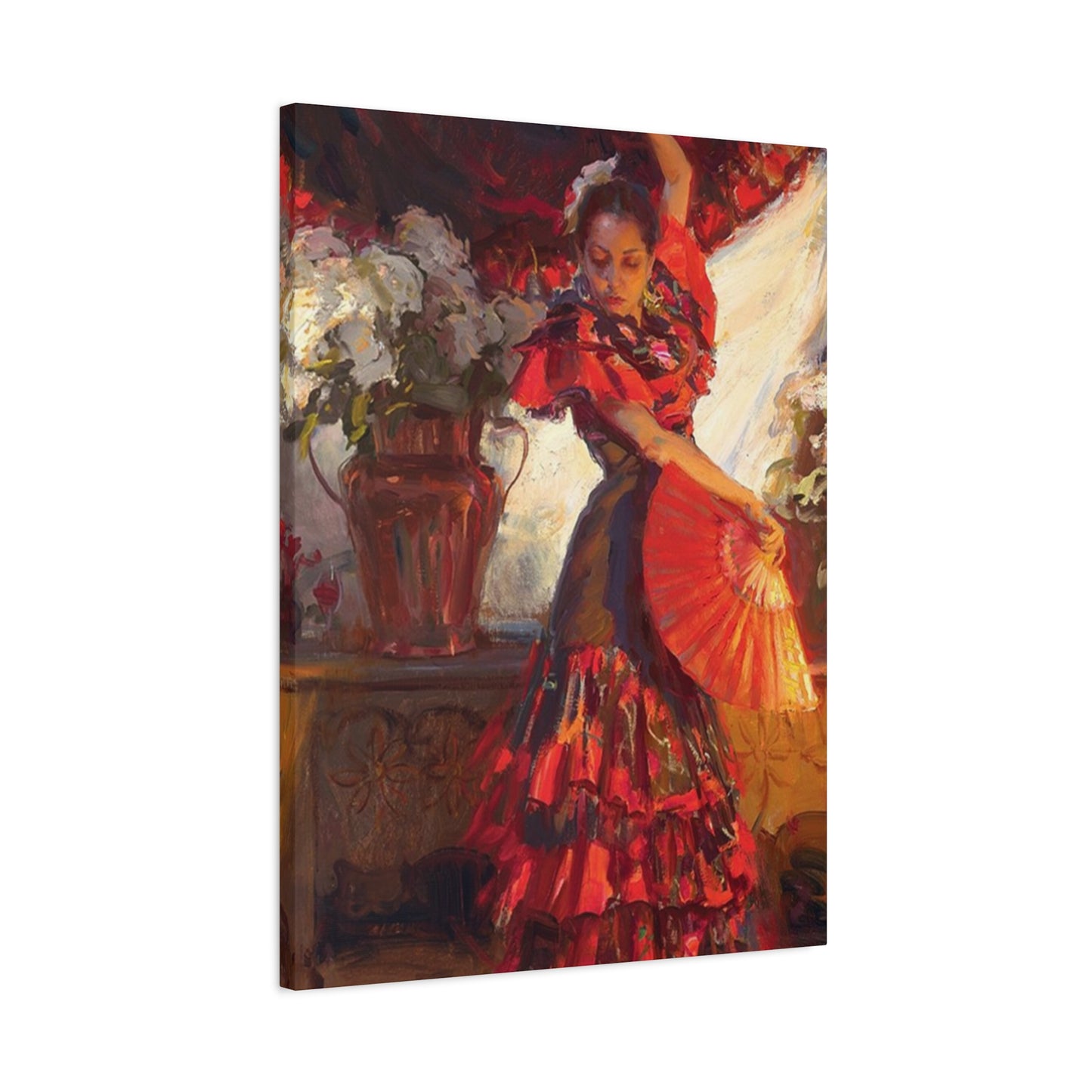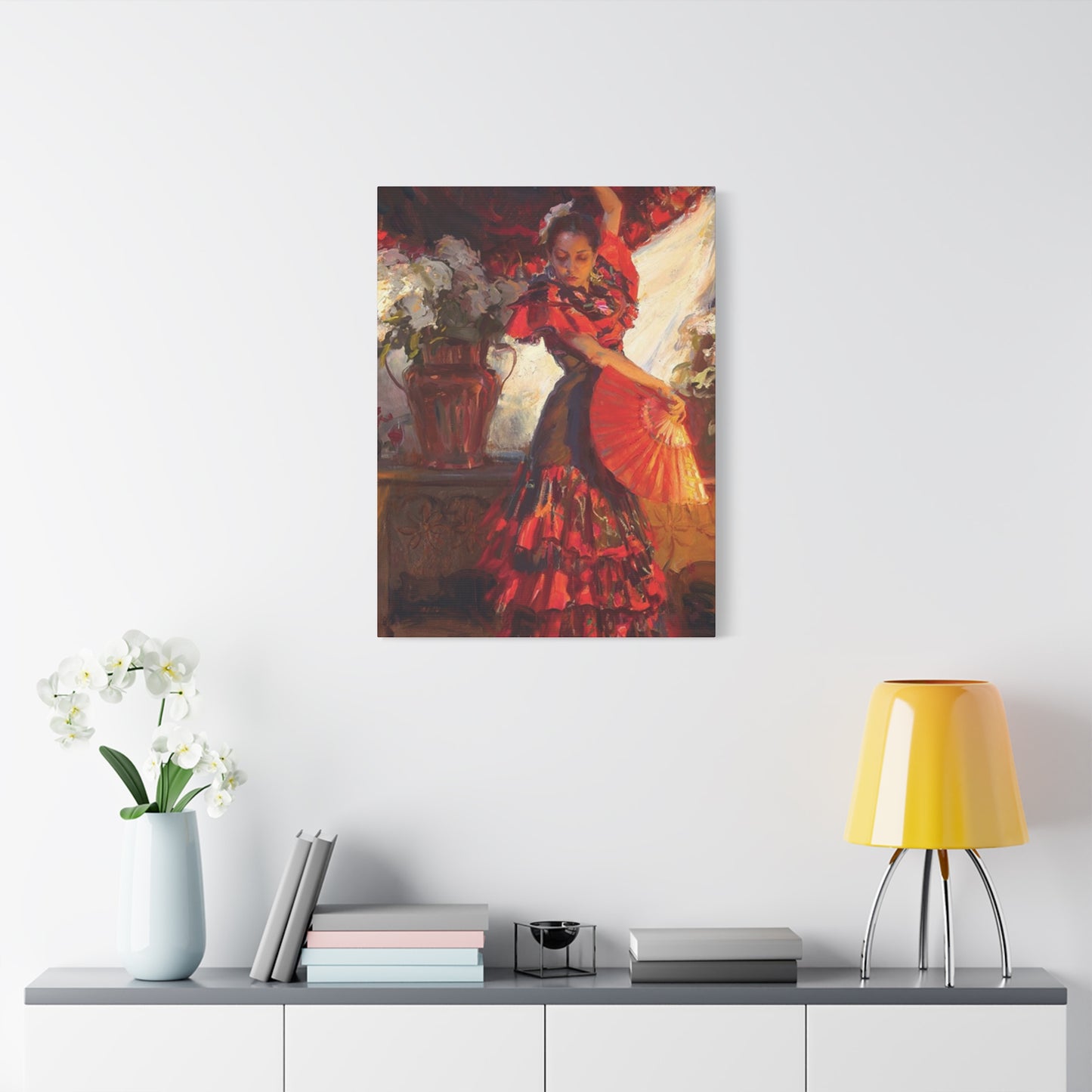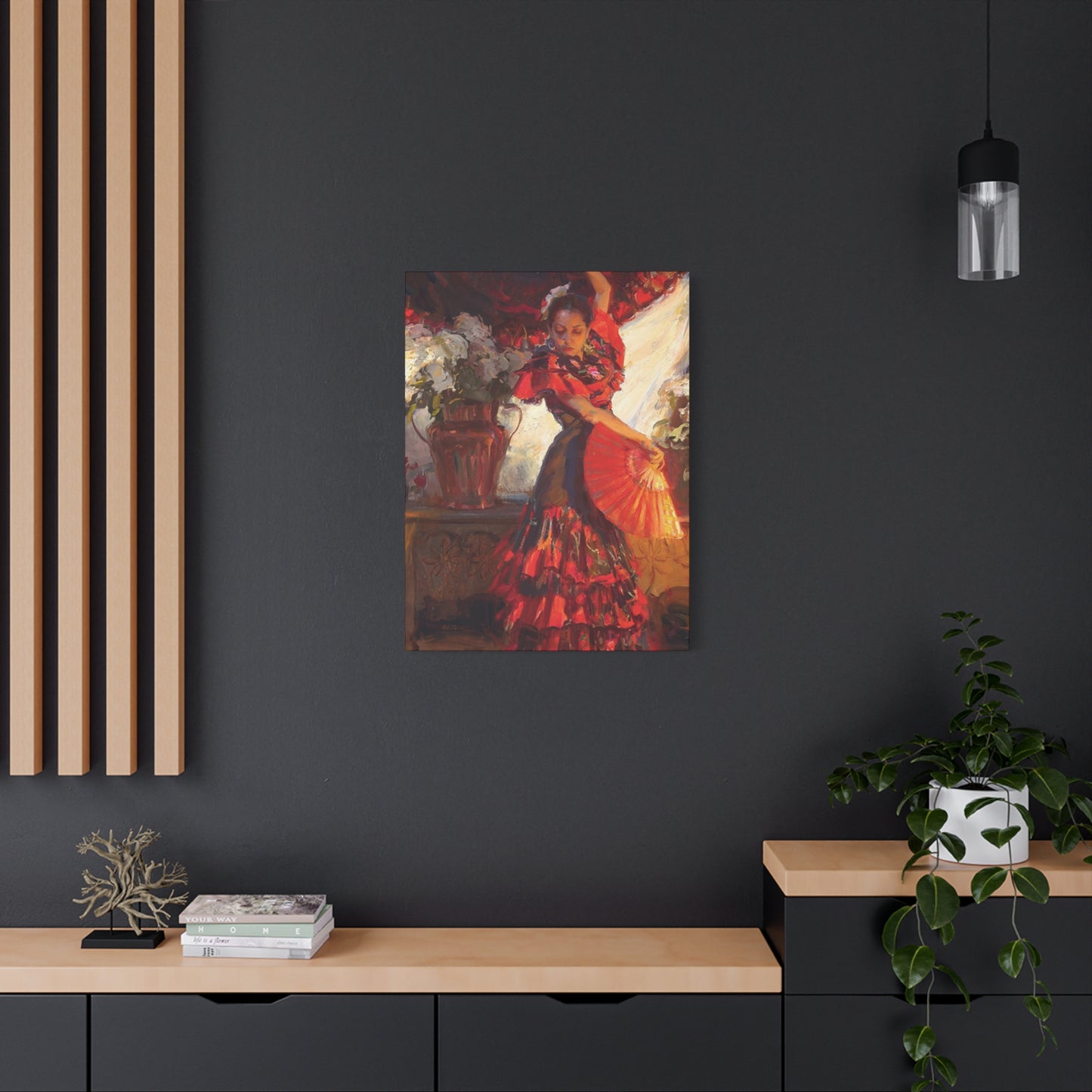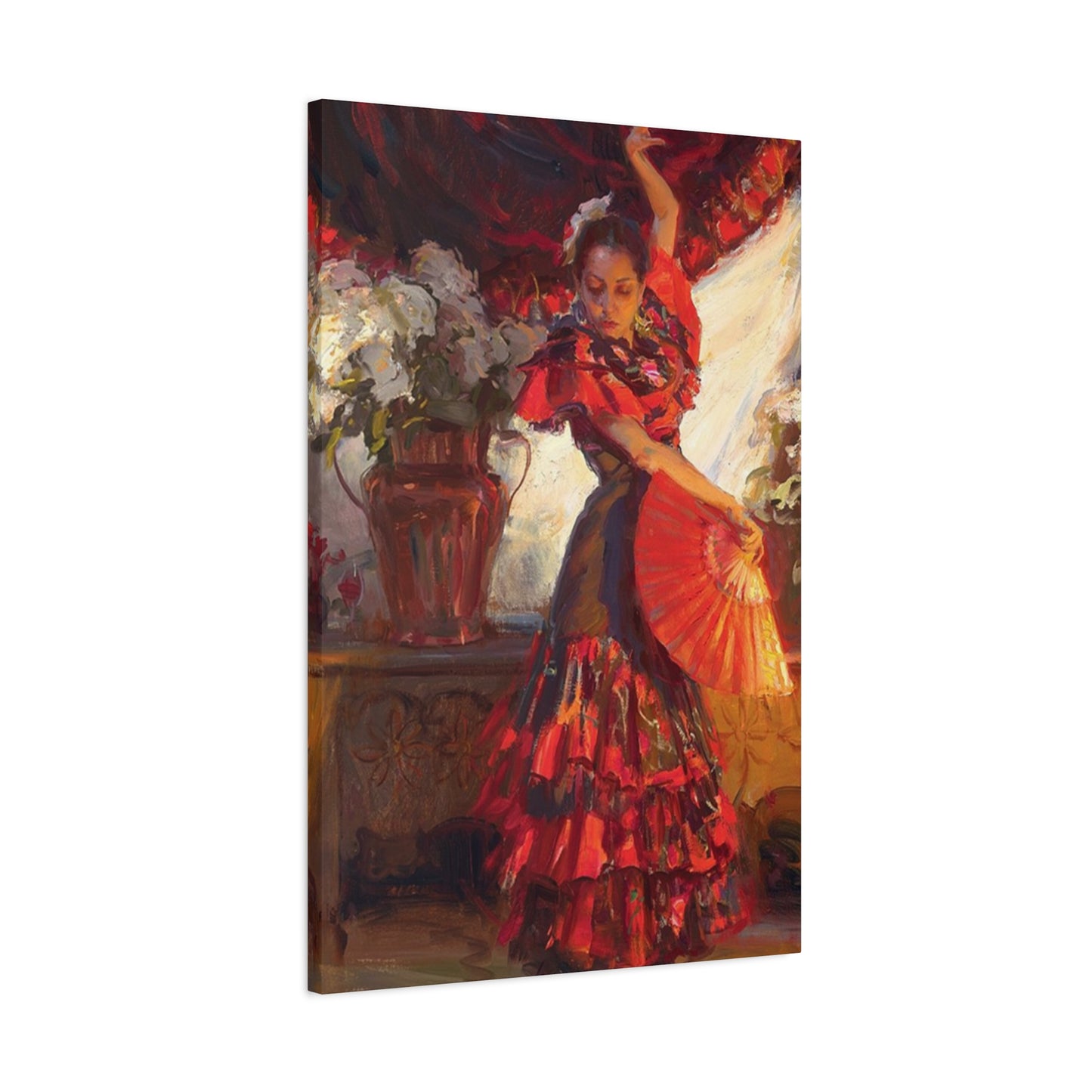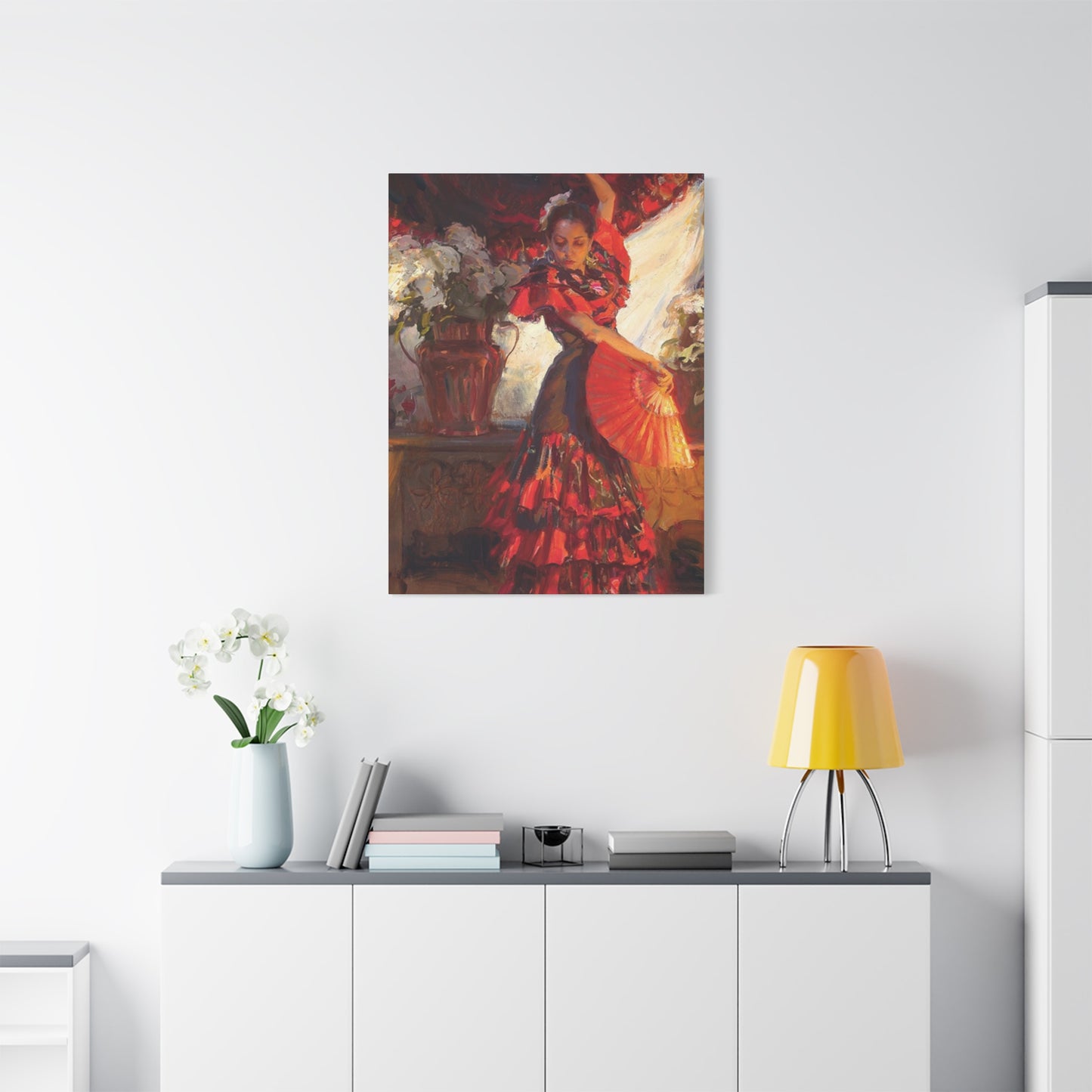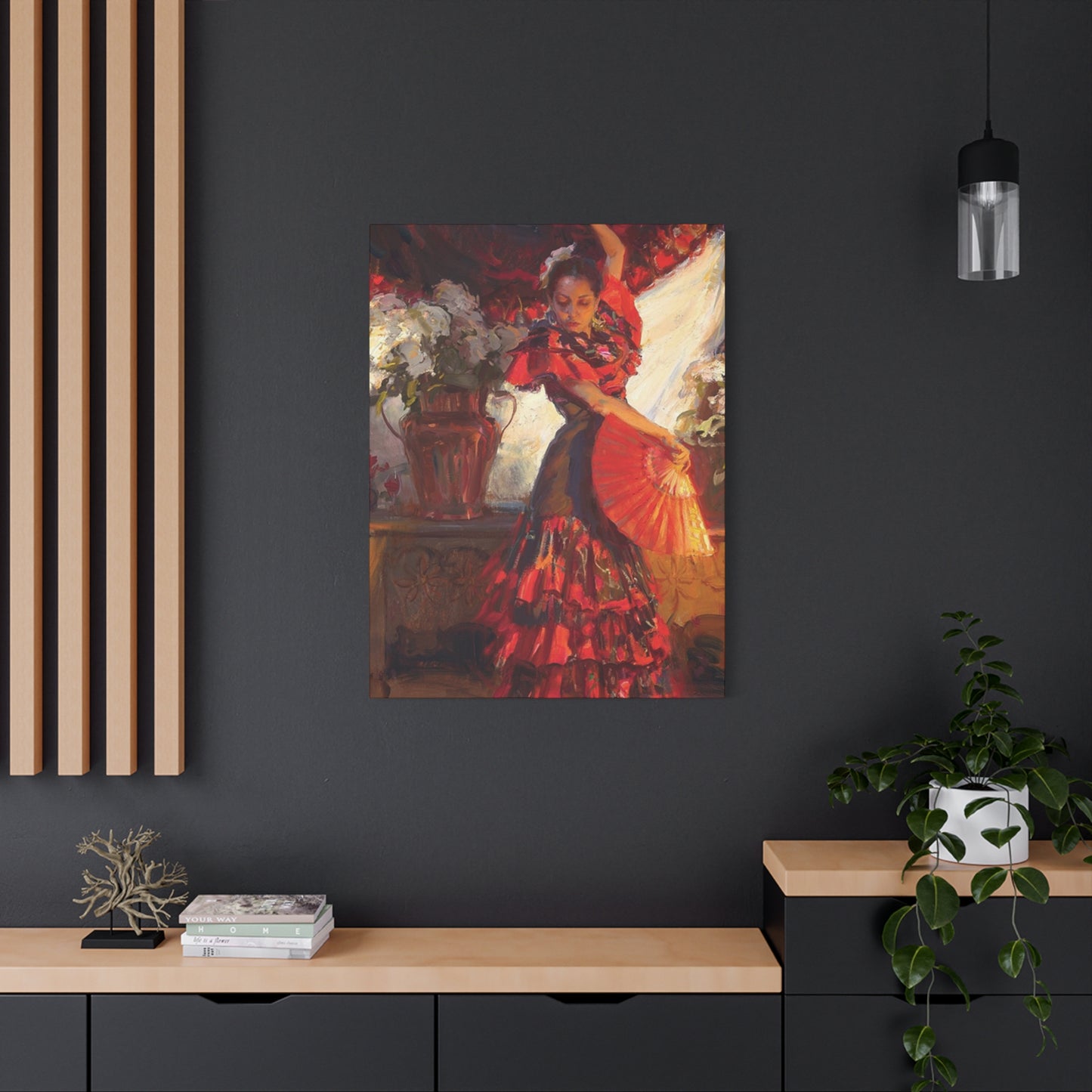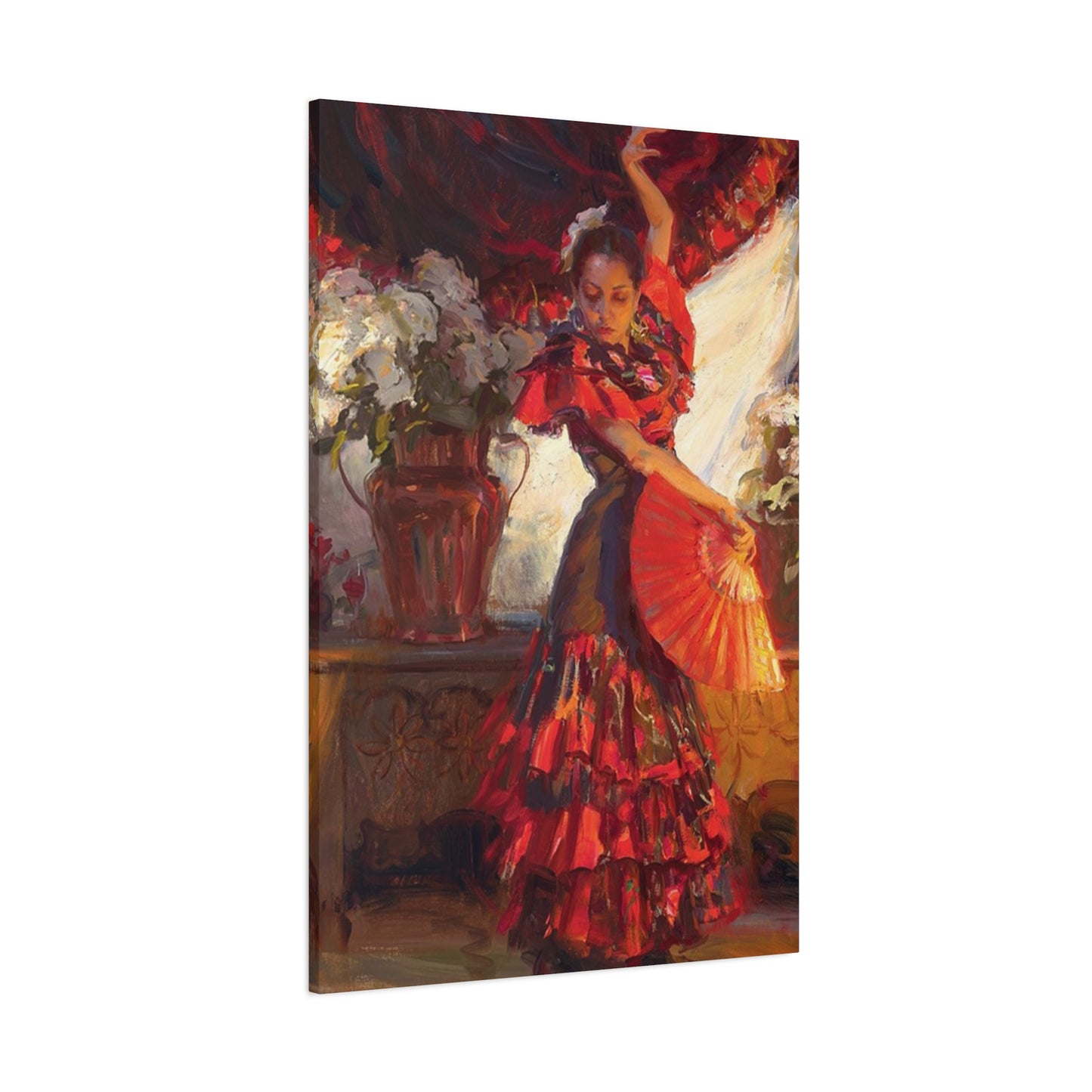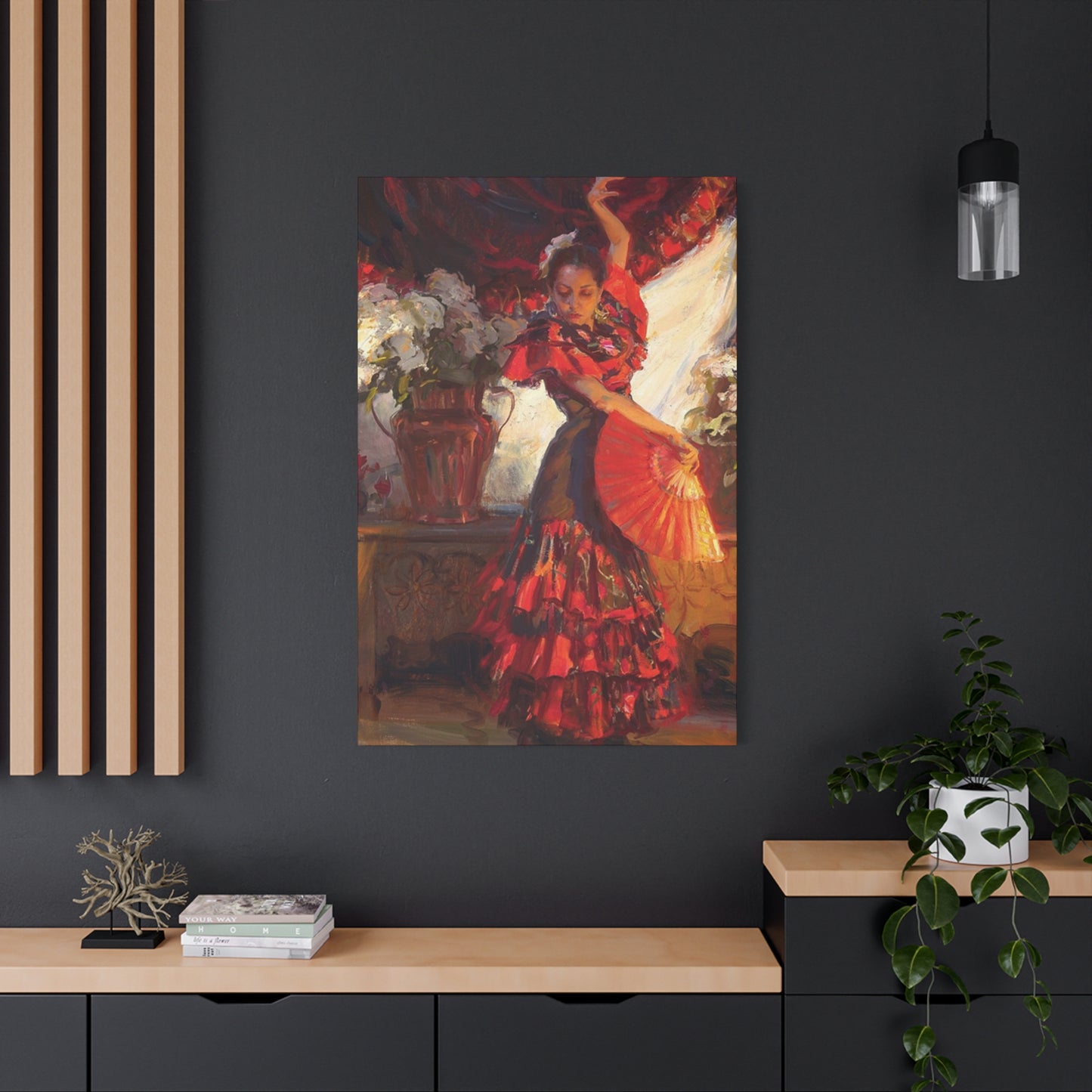Flamenco Dresses to Regional Attire: Celebrating Spain’s Diverse Traditional Wear in Art
Spain has long been recognized as a nation rich in cultural traditions, vibrant festivals, and distinctive regional identities. Among the most visually striking aspects of Spanish heritage is the traditional clothing worn throughout various regions, particularly the iconic flamenco dresses, matador costumes, and folk attire that have become symbols of Spanish identity. These stunning garments, with their bold colors, intricate patterns, and dramatic silhouettes, have transcended their original purpose to become celebrated subjects in contemporary home décor. Wall art featuring Spanish traditional wear has emerged as a popular choice for those seeking to infuse their living spaces with cultural sophistication, artistic flair, and a connection to Mediterranean heritage.
The transformation of traditional Spanish clothing into canvas prints represents a fascinating intersection of cultural preservation and modern interior design. These artistic representations capture the essence of Spanish tradition while offering homeowners an opportunity to celebrate global culture within their personal spaces. From the sweeping ruffles of a flamenco dancer's dress to the embroidered details of regional folk costumes, these images bring the passion and elegance of Spanish culture into homes around the world.
The Cultural Significance Behind Spanish Traditional Clothing
Spanish traditional wear encompasses a diverse array of garments that vary significantly across different regions and historical periods. Each piece of clothing tells a story about the people who created and wore it, reflecting local customs, climate conditions, social hierarchies, and artistic sensibilities. The traditional attire of Spain is not merely functional clothing but rather a complex system of visual communication that expresses regional pride, religious devotion, and cultural identity.
The roots of Spanish traditional clothing can be traced back centuries, with influences from Roman, Moorish, and Christian cultures blending to create distinctive regional styles. In Andalusia, the flamenco dress evolved from the simple cotton dresses worn by working-class women in the nineteenth century. These practical garments gradually transformed into the elaborate, ruffled creations we recognize today, adorned with polka dots, flowers, and vibrant colors that reflect the passionate spirit of flamenco music and dance.
In the northern regions of Spain, traditional clothing took different forms adapted to cooler climates and different cultural influences. The Basque Country developed its own distinctive style featuring berets, wool vests, and striped shirts that reflected the maritime heritage of coastal communities. Catalonia's traditional dress included the barretina cap and distinctive aprons that signified regional pride and cultural distinctiveness.
The matador's traje de luces, or suit of lights, represents another iconic element of Spanish traditional wear. These spectacular costumes, heavily embroidered with gold or silver thread and adorned with sequins, were designed to catch the light in the bullring while allowing the matador freedom of movement. The elaborate jackets, tight pants, and distinctive montera hats have become powerful symbols of Spanish tradition, even as bullfighting itself has become increasingly controversial.
Religious festivals throughout Spain have also contributed to the rich tapestry of traditional clothing. During Holy Week processions, participants wear distinctive robes and pointed hoods that date back centuries. Festival costumes for events like Las Fallas in Valencia or the Running of the Bulls in Pamplona feature specific elements that connect contemporary celebrants to generations of tradition.
When these traditional garments are captured in wall art and canvas prints, they carry this deep cultural significance into modern homes. Each image serves as a window into Spanish history, offering viewers a connection to traditions that have been passed down through generations. The visual impact of these costumes, with their bold colors and dramatic designs, makes them particularly well-suited to artistic representation, allowing the essential character of Spanish culture to be preserved and celebrated through decorative art.
Flamenco Fashion as Artistic Inspiration for Home Décor
The flamenco dress stands as perhaps the most immediately recognizable symbol of Spanish traditional wear, and its popularity in wall art reflects its powerful visual appeal. These magnificent garments, known in Spanish as trajes de flamenca or trajes de gitana, have evolved into true works of wearable art. Their translation into canvas prints allows homeowners to capture the drama and elegance of flamenco culture without the ephemeral nature of live performance.
The typical flamenco dress features a fitted bodice that hugs the torso before flaring dramatically at the hips or knees. Multiple layers of ruffles, called volantes, cascade down the skirt, creating movement and volume that mirrors the dramatic footwork and arm movements of flamenco dance. These ruffles may begin at various points on the skirt, with some dresses featuring volantes from the knee down, while others are covered in layers from hip to hem. The visual effect is one of constant motion, even when the dress is still, making flamenco fashion particularly captivating in photographic and painted representations.
Color plays a crucial role in flamenco fashion, and this element translates beautifully into wall art. Traditional flamenco dresses come in every hue imaginable, from classic red, black, and white to vibrant yellows, purples, greens, and blues. Many feature bold patterns, with polka dots being perhaps the most iconic. The lunar pattern, as polka dots are known in Spanish, can vary from tiny pinpoints to large circles, creating different visual effects. Floral patterns also feature prominently, with roses being particularly popular, often appearing as large prints or as three-dimensional fabric flowers attached to the dress.
When captured in canvas prints, these color combinations and patterns can be selected to complement specific interior design schemes. A bold red flamenco dress photograph might serve as a striking focal point in a neutral room, while a softer pastel dress image could add a romantic touch to a bedroom or sitting area. The variety of colors and patterns available in flamenco fashion means there is virtually always an option that can work with any décor style.
Regional Variations in Spanish Traditional Costume Depicted in Canvas Art
While flamenco fashion dominates popular perceptions of Spanish traditional wear, the country's regional diversity has produced numerous distinctive costume styles, each with its own aesthetic and cultural significance. Wall art and canvas prints that showcase these regional variations offer a more nuanced perspective on Spanish culture, celebrating the diversity that exists within national identity.
The traditional dress of the Valencia region features distinctive elements that reflect its Mediterranean location and agricultural heritage. Women's costumes include the gonella, a pleated skirt, worn with an ornate bodice and an elaborate silk shawl. The hair is typically arranged in distinctive coils over the ears, called moños, decorated with combs and pins. The overall effect is elegant and refined, quite different from the passionate drama of Andalusian flamenco wear. Canvas prints featuring Valencian traditional dress often capture festival participants during Las Fallas or other regional celebrations, with the detailed embroidery and jewelry clearly visible.
In Galicia, the northwestern region of Spain, traditional clothing reflects Celtic influences and the cooler, wetter climate. Women's costumes feature wool skirts, embroidered aprons, and distinctive black bodices. Headscarves and shawls are common, serving both practical and decorative purposes. Men's traditional attire includes wool vests, wide-brimmed hats, and leather accessories. The color palette tends toward earth tones and deep jewel colors, creating a different aesthetic from the bright primaries often associated with southern Spanish dress. Wall art featuring Galician traditional wear often emphasizes the craftsmanship visible in the embroidery and weaving, highlighting textile arts that have been practiced for centuries.
The Canary Islands, despite being Spanish territory, have developed their own distinctive traditional clothing styles influenced by their location off the African coast. Women's costumes feature full skirts, often striped or featuring distinctive patterns, worn with white blouses and colorful bodices. Straw hats and elaborate jewelry complete the ensemble. Men wear simple white shirts with colorful vests and sashes. The overall effect is cheerful and practical, adapted to island life. Canvas prints of Canarian traditional wear often capture the bright sunshine and outdoor settings typical of island festivals.
Castile, the historical heart of Spain, has its own traditional clothing styles that reflect its role as the seat of Spanish royalty and its position in the country's interior. Women's costumes feature long skirts, often black or dark-colored, with embroidered aprons and shawls. The style is generally more conservative and formal than southern Spanish dress, reflecting Castilian pride and traditional Catholic values. Men's traditional attire includes the distinctive Castilian cape and flat cap. Wall art featuring Castilian traditional wear often has a more subdued color palette but showcases exquisite embroidery and craftsmanship.
The Artistic Elements That Make Spanish Traditional Wear Ideal for Wall Art
The visual characteristics that make Spanish traditional clothing so striking in person translate remarkably well to two-dimensional artistic representation, which explains the popularity of these images in home décor. Several specific artistic elements contribute to the effectiveness of Spanish traditional wear as subjects for canvas prints and wall art.
Color is perhaps the most obvious and impactful element. Spanish traditional clothing embraces bold, saturated colors that create immediate visual impact. The reds are deep and vibrant, reminiscent of Spanish wine or the cape of a matador. Yellows range from soft pastels to intense sunflower hues. Blues span from pale sky tones to deep midnight shades. These strong colors reproduce beautifully in photographic and painted representations, maintaining their intensity and emotional impact. When displayed as wall art, these colors can serve as accent pieces that tie together a room's color scheme or as bold statements that set the tone for an entire space.
Pattern provides another layer of visual interest in Spanish traditional wear. Beyond the iconic polka dots, traditional Spanish clothing features stripes, florals, geometric designs, and abstract patterns. Many garments combine multiple patterns, creating visual complexity that rewards close viewing. In canvas prints, these patterns create texture and depth, preventing images from appearing flat or static. The interplay of patterns, particularly in photographs that capture fabric in motion, creates dynamic visual interest that holds viewer attention.
Textile texture contributes significantly to the visual appeal of Spanish traditional wear, and skilled photographers and artists can capture this quality in two-dimensional representations. The crisp cotton of a summer flamenco dress has a different character from the heavy silk of a Manila shawl or the rough wool of a Galician vest. Lace, embroidery, sequins, and beading all create distinctive visual textures that add richness to images. When reproduced as canvas prints, these textural qualities can be enhanced through printing techniques that add dimension and tactile interest to the artwork.
Silhouette and form play crucial roles in the visual impact of Spanish traditional clothing. The dramatic hourglass shape of a flamenco dress, the flowing lines of a mantilla, the structured formality of a matador's jacket, these distinctive silhouettes are immediately recognizable and inherently artistic. In wall art, these shapes create strong compositional elements that can balance and anchor other design elements in a room. The movement implied in the form of traditional Spanish clothing, even when stationary, adds energy and life to static images.
Light and shadow interact dramatically with Spanish traditional wear, creating opportunities for striking photographic and painted representations. The ruffles of a flamenco dress create constantly changing patterns of light and dark as fabric layers overlap. Sequins and embroidery catch light, creating points of brightness that draw the eye. The contrast between light fabrics and dark ones, or between illuminated areas and shadows, adds depth and dimensionality to images. Canvas prints that effectively capture these light effects can create the illusion of three-dimensional form on a flat surface.
Incorporating Spanish Traditional Wear Canvas Prints into Various Interior Design Styles
The versatility of Spanish traditional wear as a subject for wall art means these pieces can be successfully incorporated into a wide range of interior design styles. The key lies in selecting images and presentation styles that complement and enhance existing décor rather than conflicting with it.
In Mediterranean-style interiors, canvas prints featuring Spanish traditional wear form a natural and cohesive addition. These design schemes typically feature warm earth tones, terracotta, ochre, and burnt sienna, with accents of deep blue and bright white. Textural elements like wrought iron, rough plaster walls, and terra cotta tiles create a rustic elegance. In this context, wall art depicting Spanish traditional clothing reinforces the Mediterranean theme while adding specific cultural focus. Images featuring the warm reds and golds of Andalusian costumes or the earth tones of Castilian dress work particularly well. The artwork can be framed in wrought iron frames or distressed wood to maintain consistency with the overall aesthetic.
Modern minimalist interiors might seem an unlikely setting for traditional Spanish costume imagery, but carefully selected pieces can create striking contrasts that energize these spaces. In a room dominated by clean lines, neutral colors, and simple forms, a single large-scale canvas print of a flamenco dancer in a bold red dress becomes a powerful focal point. The key is to treat the artwork as the room's statement piece, allowing it to provide the color, pattern, and cultural warmth that minimalist spaces can sometimes lack. Frame selection should be simple and unadorned, perhaps a thin black metal frame or a floating canvas mount, to maintain the minimalist aesthetic while allowing the image itself to shine.
Bohemian or eclectic interiors naturally accommodate Spanish traditional wear artwork, as these design styles celebrate cultural mixing and artistic expression. In spaces featuring global textiles, vintage furniture, abundant plants, and collected objects from various cultures, canvas prints of Spanish traditional clothing add another layer of cultural richness. These interiors can accommodate multiple pieces in different sizes and styles, creating gallery walls that tell visual stories. Mixing photographs of flamenco dancers with painted interpretations of regional costumes, or combining color and black-and-white images, creates the layered, collected-over-time aesthetic that defines bohemian style.
Contemporary interiors, characterized by current design trends and up-to-date furnishings, can incorporate Spanish traditional wear art to add cultural depth and visual interest. These spaces often feature a neutral base palette with carefully selected accent pieces. In this context, canvas prints of traditional Spanish clothing can serve as those accent pieces, introducing color, pattern, and personality without overwhelming the space. Close-up details of embroidery or textile patterns work particularly well in contemporary settings, as they can appear almost abstract while maintaining their cultural significance. Sleek, modern framing keeps the artwork feeling current rather than nostalgic.
Photographic versus Painted Representations of Spanish Traditional Clothing
Canvas prints of Spanish traditional wear can take many forms, from realistic photographs to impressionistic paintings, and the choice between these approaches significantly affects both the aesthetic impact and the cultural resonance of the artwork.
Photographic representations offer the advantage of documentary authenticity, capturing actual costumes, real people, and specific moments in time. High-quality photographs of traditional Spanish clothing can showcase intricate details that might be simplified or lost in painted interpretations, the precise pattern of embroidery stitches, the exact drape of fabric, the authentic color combinations used in actual garments. For viewers interested in the ethnographic and historical aspects of Spanish traditional wear, photographs provide valuable documentation of how these costumes actually appear.
Contemporary photography of Spanish traditional wear often employs professional lighting, composition, and post-processing techniques that elevate documentary images into artistic statements. A photographer might capture a flamenco dancer frozen mid-movement, with dramatic side lighting that emphasizes the motion of ruffles and creates powerful shadows. Post-processing can enhance colors, adjust contrast, or add artistic effects like selective coloring or vignetting. The result is artwork that maintains photographic authenticity while demonstrating clear artistic vision and technical skill.
Vintage or historical photographs of Spanish traditional wear offer different aesthetic qualities and cultural significance. These images document how traditional costumes appeared in earlier eras, showing evolution in style and providing glimpses into historical contexts. The aged quality of historical photographs, with their characteristic graininess, sepia tones, or faded colors, adds nostalgic appeal and a sense of connection to the past. For interiors with vintage or traditional design aesthetics, historical photographs of Spanish traditional wear can be particularly appropriate.
Creating Gallery Walls with Spanish Traditional Wear Artwork
Gallery walls offer an excellent opportunity to showcase multiple pieces of Spanish traditional wear artwork, creating visual impact through curated collection rather than a single statement piece. The process of creating an effective gallery wall requires attention to relationships between individual pieces, overall composition, and integration with the surrounding space.
The first consideration in creating a gallery wall featuring Spanish traditional wear art is selecting pieces that relate to each other while offering enough variety to create visual interest. A gallery wall might focus exclusively on flamenco imagery, showing dancers in various poses and costumes, or it might showcase the diversity of Spanish regional dress, with each piece representing a different area of the country. Another approach might mix different artistic interpretations of similar subjects, combining photographs, paintings, and perhaps prints or illustrations of traditional Spanish costumes.
Color coordination plays a crucial role in creating cohesive gallery walls. One approach involves selecting pieces that share a similar color palette, creating harmony through color relationships. For example, a gallery wall might feature multiple images of red and black traditional costumes, creating a bold, dramatic statement through color unity. Alternatively, pieces might represent the full spectrum of colors found in Spanish traditional wear, creating a rainbow effect that celebrates the diversity of traditional costumes. A more sophisticated approach involves identifying a dominant color family with variations in saturation and value, creating unity through color relationships while maintaining visual variety.
Size relationships between pieces significantly affect gallery wall composition. Symmetrical arrangements might use identically sized frames arranged in a grid pattern, creating a formal, organized appearance. Asymmetrical arrangements mix different sizes, with larger pieces serving as anchor points and smaller pieces filling in around them. The classic salon-style hanging uses varied sizes arranged organically to fill the wall space, creating a collected-over-time appearance. When working with Spanish traditional wear imagery, size can also relate to importance or emphasis, with larger pieces highlighting particularly significant costumes or particularly striking images.
Frame selection and consistency affect whether a gallery wall feels cohesive or chaotic. One approach uses identical frames throughout, creating unity through consistency of presentation. This works well when the artwork itself is varied, as the uniform framing provides structure. Alternatively, frames might vary but share common characteristics, perhaps all in wood tones or all in metallic finishes. The variation adds visual interest while maintaining overall harmony. More eclectic approaches mix frame styles deliberately, but this requires a sophisticated eye to avoid appearing random or careless.
The Role of Spanish Traditional Wear Art in Cultural Education and Appreciation
Beyond their decorative value, canvas prints and wall art featuring Spanish traditional wear serve important cultural functions, offering opportunities for education, appreciation, and connection to heritage. These artistic representations can spark curiosity, prompt conversations, and deepen understanding of Spanish culture among residents and visitors alike.
For families with Spanish heritage, artwork depicting traditional costumes can serve as meaningful connections to ancestral culture. Children growing up in homes where such artwork is displayed absorb visual cues about their family's cultural background, even before they can fully understand the historical and social contexts. These images can prompt questions and conversations about family history, regional origins, and traditional practices. Grandparents can share stories about festivals they attended, costumes they wore, or memories associated with the traditional clothing depicted in the artwork.
The educational value extends beyond families with direct cultural connections. For anyone interested in global cultures, Spanish traditional wear artwork offers a window into a rich cultural tradition. Each costume carries information about regional identity, social class, historical period, and cultural values. By researching the specific costumes depicted in their artwork, homeowners can learn about Spanish geography, history, and social customs. This learning enriches the artwork beyond its aesthetic appeal, creating layers of meaning and interest.
The presence of Spanish traditional wear art in homes can prompt cross-cultural conversations when guests visit. Explaining the significance of a flamenco dress, the regional variations in traditional costumes, or the history behind a particular style creates opportunities for cultural exchange and mutual learning. These conversations can combat stereotypes and oversimplifications, replacing them with nuanced understanding of Spanish cultural diversity and complexity.
For educators, Spanish traditional wear artwork can serve as teaching tools in home-based learning environments. Images of traditional costumes can accompany lessons about Spanish history, geography, music, dance, or art. Children can learn to identify different regions of Spain by their distinctive traditional dress, understand how climate and economy influence clothing choices, or explore the craftsmanship involved in creating elaborate traditional garments. This visual learning complements textual information and makes cultural education more engaging and memorable.
Selecting Quality Canvas Prints of Spanish Traditional Wear
The quality of canvas prints significantly affects both their visual impact and longevity, making informed selection important for anyone investing in Spanish traditional wear artwork. Understanding the factors that determine quality helps buyers make choices that will satisfy both immediately and over time.
Image resolution stands as the most fundamental quality factor in photographic canvas prints. High-resolution images contain sufficient detail to be printed at large sizes without appearing pixelated or blurry. Professional photographers typically capture images at resolutions far exceeding what's necessary for screen viewing, specifically to allow for large-format printing. When selecting canvas prints, buyers should verify that images were captured and will be printed at resolutions appropriate for the intended size. Low-resolution images stretched to large formats reveal their limitations, with visible pixelation destroying the illusion of photographic reality.
Color accuracy and vibrancy affect how faithfully printed images represent the original costumes or artistic vision. Professional printing processes use color management systems to ensure colors reproduce accurately. However, significant variations exist between different printing technologies and quality levels. The inks or dyes used, the canvas material itself, and the printing process all affect color reproduction. High-quality prints feature rich, saturated colors that match the source image, with smooth color transitions and accurate skin tones. Poor-quality prints may show color shifts, banding where smooth transitions should occur, or dull, lifeless colors that fail to capture the vibrancy of traditional Spanish clothing.
Canvas material quality varies considerably across available products. Professional-grade canvas made from cotton or poly-cotton blends provides superior texture, durability, and color acceptance compared to cheaper synthetic materials. The weave of the canvas affects both appearance and durability, with tighter weaves generally offering smoother surfaces and longer life. The canvas coating or priming prepares the surface for printing and affects color vibrancy and fade resistance. High-quality canvases accept ink evenly and prevent color bleeding while maintaining the characteristic texture that distinguishes canvas from paper prints.
Printing technology affects both quality and longevity. Giclée printing, using archival inks and professional-grade equipment, produces museum-quality prints with exceptional detail, color accuracy, and fade resistance. These prints can last decades or even centuries under proper conditions. Standard digital printing produces acceptable results for many applications but may not match giclée quality in terms of color gamut, detail resolution, or longevity. Understanding which printing technology was used helps buyers assess whether price and quality align appropriately.
Placement and Display Considerations for Spanish Traditional Wear Canvas Art
The location and manner of displaying Spanish traditional wear canvas art significantly affects both its visual impact and its longevity. Strategic placement decisions maximize the artwork's contribution to interior design while protecting it from environmental damage.
Height placement follows general art hanging guidelines while accounting for viewing context. The center of artwork should typically be at eye level, approximately fifty-seven to sixty inches from the floor, matching average human eye height. However, this guideline requires adjustment based on room function and furniture arrangement. Artwork hung above furniture should be positioned eight to twelve inches above the furniture top, creating visual connection without awkward gaps. In spaces where people are typically seated, such as dining rooms or conversation areas, slightly lower placement accommodates the seated viewing position.
Wall selection considers both aesthetic and practical factors. Focal point walls, the first wall visible when entering a room or the wall that naturally draws attention, are prime locations for statement pieces of Spanish traditional wear art. These prominent positions deserve artwork that confidently commands attention, such as large-scale flamenco dancer photographs or dramatic triptychs of regional costumes. Secondary walls can accommodate smaller pieces or less visually bold images that complement the overall design scheme without competing for attention.
Lighting conditions dramatically affect how artwork appears and how well it survives over time. Direct sunlight causes rapid fading of prints and should be avoided. South-facing walls in particular receive intense sunlight that can damage artwork within months. If displaying pieces on sunny walls is unavoidable, UV-filtering window treatments or special UV-protective glass for frames provides some protection. North-facing walls receive more consistent, indirect natural light ideal for viewing artwork. Artificial lighting can be directed specifically at artwork using picture lights, track lighting, or strategically placed lamps, creating drama and ensuring good visibility regardless of natural light conditions.
Spanish Traditional Wear Art in Commercial and Hospitality Spaces
While this exploration has focused primarily on residential applications, Spanish traditional wear canvas art also finds effective use in commercial settings, particularly those with Spanish themes, cultural missions, or hospitality functions. Understanding these commercial applications provides additional context for appreciating this art form's versatility and cultural significance.
Spanish restaurants and tapas bars naturally incorporate traditional wear imagery to reinforce their cultural authenticity and create immersive dining experiences. Large-scale canvas prints of flamenco dancers can dominate feature walls, immediately communicating the restaurant's cultural identity to entering guests. Multiple pieces showcasing regional Spanish costumes might line dining room walls, with each piece representing regions that inspired menu items. The bold colors and dramatic imagery of traditional Spanish clothing complement the warm, social atmosphere restaurants aim to create, enhancing the overall dining experience through environmental storytelling.
Hotels and resorts, particularly those in Spain or those targeting travelers interested in Spanish culture, use traditional wear artwork throughout their properties. Guest room artwork might feature individual pieces selected to create calm, attractive spaces while providing cultural interest. Public spaces including lobbies, corridors, and event spaces can accommodate larger, more dramatic pieces that make bold statements about the property's cultural connections. Some properties create themed floors or wings, with artwork collections telling specific stories about Spanish regions or traditions.
Cultural centers, Spanish language schools, and community organizations serving Hispanic populations often display traditional wear artwork as part of their educational and cultural preservation missions. These spaces might include extensive collections documenting various regional costumes, historical evolution of styles, or contemporary interpretations by modern artists. Gallery walls combining artwork with explanatory text provide educational value alongside aesthetic appeal. These institutions sometimes host rotating exhibitions featuring traditional wear imagery, creating dynamic environments that encourage repeated visits.
Corporate offices of companies with Spanish connections, whether headquartered in Spain, doing significant business there, or founded by individuals of Spanish heritage, might incorporate traditional wear artwork into their office designs. This corporate art serves multiple functions including expressing company identity, creating attractive work environments, and demonstrating cultural appreciation. Executive offices, conference rooms, and reception areas commonly feature selected pieces that represent the company's relationship to Spanish culture.
Dance studios, particularly those teaching flamenco, naturally incorporate imagery of traditional Spanish dance costumes. These spaces benefit both aesthetically and functionally from such artwork, as students can study costume details and draw inspiration from the captured movements of dancers. The artwork reinforces the studio's specialized identity while creating an immersive environment that transports students into the world of flamenco culture.
Retail environments selling Spanish products, whether food stores, wine shops, or import boutiques, use traditional wear artwork to establish cultural authenticity and create distinctive shopping experiences. The artwork helps differentiate these specialty retailers from generic competitors while educating customers about Spanish culture. Some retailers commission custom artwork featuring their specific regional focus, creating unique visual branding.
Event spaces hosting Spanish-themed occasions including cultural festivals, fundraisers, or private celebrations might incorporate temporary or permanent displays of traditional wear artwork. These pieces help establish event themes and create Instagram-worthy backgrounds that encourage social media sharing, extending the event's reach beyond physical attendees. Rental artwork services sometimes provide Spanish traditional wear pieces specifically for such events.
The Market for Spanish Traditional Wear Canvas Prints and Supporting Artists
The marketplace for Spanish traditional wear canvas prints encompasses various channels, price points, and quality levels, offering options for different budgets and preferences while also creating opportunities for photographers, artists, and artisans to make livings from their creative work.
Online marketplaces have democratized access to Spanish traditional wear art, allowing consumers worldwide to browse extensive selections and purchase directly. Major print-on-demand platforms offer thousands of images featuring traditional Spanish clothing, from amateur photographs to professional artwork. These platforms typically handle printing, shipping, and customer service, allowing artists to focus on creating images while the platform manages sales logistics. Consumers benefit from wide selection, competitive pricing, and convenient shopping, though quality varies considerably across different sellers and price points.
Independent artists and photographers often sell their work through personal websites or online portfolio platforms. This direct-to-consumer model allows artists to maintain greater control over pricing, quality, and customer relationships. Buyers benefit from direct communication with creators, often gaining insights into how images were captured or created. Many artists offer customization options, allowing buyers to request specific sizes, finishing treatments, or even commission entirely new work depicting particular aspects of Spanish traditional clothing.
Art galleries, both physical and online, curate collections of Spanish traditional wear artwork, typically focusing on higher-quality or more artistic pieces. Gallery curation provides quality assurance and editorial perspective, helping buyers navigate choices. Galleries often represent specific artists, building their careers and reputations while providing collectors with confidence in their purchases. The gallery model typically involves higher prices than mass-market platforms but delivers greater quality, exclusivity, and investment potential.
Photography and art shows, festivals, and cultural events provide opportunities to view and purchase Spanish traditional wear artwork in person. These venues allow potential buyers to assess quality directly, see true colors and details, and speak with artists about their work. Many artists rely on such events for significant portions of their annual sales, particularly for higher-priced original works or limited editions. For buyers, these events offer the experience of discovering artwork in curated contexts while supporting artists directly.
Interior designers and art consultants source Spanish traditional wear artwork for clients, providing expertise in selecting appropriate pieces and managing the acquisition process. These professionals have access to trade resources, artist networks, and specialized suppliers that may not be readily available to individual consumers. Their services typically add cost but deliver valuable expertise and save clients time and potential mistakes.
Licensing and reproduction rights affect the market in various ways. Original photographs or paintings command premium prices reflecting the uniqueness and direct connection to the artist. Limited edition prints, numbered and signed by the artist, offer middle-ground options with some exclusivity at more accessible prices. Unlimited reproductions provide affordability but lack the investment potential and exclusivity of limited or original works. Understanding these distinctions helps buyers make informed decisions aligned with their priorities.
The market for Spanish traditional wear art supports various creative professionals including photographers who specialize in cultural documentation or artistic photography, painters who create original works based on traditional clothing, digital artists who create contemporary interpretations, and printers and framers who transform digital images into physical artwork. This ecosystem provides economic opportunities while preserving and promoting Spanish cultural heritage.
Ethical considerations in the marketplace include ensuring artists receive fair compensation for their work, respecting copyright and intellectual property rights, and avoiding cultural appropriation or exploitation. Responsible buyers verify that artists are properly credited and compensated, particularly when purchasing through third-party platforms. Supporting artists directly through gallery purchases or commissions ensures they receive full value for their creative work.
Clothing Depicted in Contemporary Art
The roots of Spanish traditional dress reach back to medieval times, when regional identities began forming around kingdoms that would eventually unite to create modern Spain. Clothing during this period reflected the social hierarchy, with nobility wearing silk and velvet while common people dressed in wool and linen. The Moorish presence in Spain for nearly eight centuries profoundly influenced Spanish aesthetics, introducing embroidery techniques, geometric patterns, and flowing garment styles that persisted even after the Reconquista. The fusion of Moorish, Christian, and Jewish cultural elements created distinctive Spanish aesthetics visible in surviving traditional costumes.
The sixteenth and seventeenth centuries, Spain's Golden Age, saw Spanish fashion influence all of Europe. The rigid, formal styles of the Spanish court, featuring black garments adorned with intricate gold or silver embroidery, represented power and piety. While court fashion differed significantly from folk dress, elite styles filtered down through society in simplified forms, influencing what eventually became regional traditional costumes. The ruff collar, tight bodices, and voluminous skirts that characterized Spanish Golden Age fashion echo in various regional traditional dresses still worn today.
The eighteenth century brought Bourbon rule to Spain, introducing French influences that competed with traditional Spanish aesthetics. Regional traditional dress began solidifying during this period as a way of asserting local identity against centralizing pressures from Madrid. Different regions consciously developed or preserved distinctive costume elements that expressed regional pride. This period saw the formalization of many elements now considered quintessentially traditional, from specific embroidery patterns to particular ways of arranging headscarves.
The nineteenth century proved crucial for the development of traditional Spanish clothing into the forms most commonly depicted in contemporary art. Romantic movement artists and writers, both Spanish and foreign, celebrated Spanish regional culture and helped popularize images of traditional dress. The flamenco dress as we know it today emerged during this century, evolving from simple working clothes into the elaborate, ruffled creations that became synonymous with Spanish identity. The matador's costume also took its modern form during this period, influenced by dandyism and the increasing commercialization of bullfighting.
The early twentieth century saw both continued evolution and deliberate preservation of traditional costume. The rise of regional nationalism, particularly in Catalonia and the Basque Country, made traditional dress politically significant as a symbol of regional identity. Folk music and dance revival movements embraced traditional costumes, standardizing certain elements while allowing for creative interpretation. Photography began documenting traditional dress systematically, creating visual records that inform contemporary understanding and reproduction.
The Spanish Civil War and subsequent Franco dictatorship had complex effects on traditional dress. The regime promoted certain aspects of traditional Spanish culture, particularly flamenco and bullfighting, as symbols of essential Spanish identity while suppressing regional languages and customs. This complicated relationship meant traditional dress continued to evolve but within politically charged contexts. Some regional costumes were suppressed as symbols of dangerous separatism, while others were promoted as symbols of unified Spanish identity.
The post-Franco era brought renewed pride in regional identities and cultural traditions. Traditional dress experienced revival as regions reclaimed their cultural heritage free from political repression. This period also saw increased interest in historical accuracy, with researchers documenting traditional costume elements that had been forgotten or simplified. Contemporary traditional dress often reflects this research, incorporating historical details that earlier twentieth-century versions had lost.
Today's traditional Spanish costumes, as depicted in contemporary canvas art, represent living traditions that continue evolving while maintaining connections to historical forms. Modern flamenco dresses incorporate contemporary fashion sensibilities while respecting traditional elements. Regional festival costumes balance historical accuracy with practical considerations and individual expression. This dynamic evolution ensures traditional Spanish dress remains relevant and meaningful rather than becoming museum artifacts.
Creating Themed Room Designs Around Spanish Traditional Wear Art
A flamenco-inspired living room builds around the dramatic aesthetics of Andalusian dance culture. The centerpiece might be a large canvas print of a dancer in a vivid red dress, positioned as the room's focal point. The color palette draws from flamenco traditions with deep reds, blacks, and whites as primary colors, accented by gold tones. Furniture selection might include Spanish or Mediterranean-style pieces with carved wood details, or surprisingly, stark modern furniture that echoes the clean lines and drama of flamenco performance. Textile choices embrace the patterns common in flamenco fashion including polka dots in throw pillows, floral prints in curtains, and fringe details in throws or lampshades that reference the movement of ruffles.
Decorative accessories might include Spanish guitars as wall sculptures, decorative fans, castanets displayed as art objects, and perhaps authentic peinetas or mantillas in shadow boxes. Lighting should be dramatic, with dimming capabilities to create the intimate atmosphere of a tablao flamenco. The overall effect transports visitors to the passionate world of flamenco culture while maintaining functionality as a contemporary living space.A regional Spanish festival room celebrates the diversity of Spanish traditions across different regions. Multiple canvas prints showcase traditional costumes from Catalonia, Valencia, Galicia, the Basque Country, and other regions, creating a gallery wall that educates while decorating.
The color palette might be more varied than single-theme rooms, incorporating the diverse colors of different regional costumes while maintaining overall harmony through careful curation. Furniture could include antique or reproduction Spanish provincial pieces that reference rural traditions. Textiles might feature traditional Spanish weaving patterns or embroidery styles. Decorative accessories could include regional ceramics, perhaps Talavera pottery or Catalan jugs, along with maps highlighting Spanish regions and explanatory texts that help guests understand the traditional costumes depicted. This approach creates a room that serves educational purposes alongside aesthetic ones, making it ideal for cultural enthusiasts or families maintaining connections to Spanish heritage.
A contemporary fusion room combines Spanish traditional wear art with modern design elements, creating spaces that honor tradition while embracing current aesthetics. Canvas prints might feature artistic or abstract interpretations of traditional costumes rather than documentary photographs, perhaps close-ups of textile details or motion-blur images that capture energy more than literal forms. The color palette might extract specific colors from traditional costumes but use them in contemporary ways, perhaps a single accent wall in flamenco red while other walls remain white or neutral. Furniture would be contemporary, possibly mid-century modern or sleek minimalist pieces that provide intentional contrast with the traditional subject matter. This juxtaposition creates visual tension that makes both the artwork and the furniture more interesting than either would be alone. Accessories might include contemporary Spanish design objects, modern ceramics, or abstract sculptures.
Conclusion:
In conclusion, the rich tapestry of Spain’s traditional attire—from the vibrant flamenco dresses to the distinctive regional costumes—stands as a vivid celebration of the country’s diverse cultural heritage. Through art, these garments transcend mere fabric and become powerful symbols of identity, history, and community. Artistic depictions of Spanish traditional wear capture not only the beauty and craftsmanship of the clothing but also the stories, values, and emotions woven into every stitch and pattern.
One of the most enchanting aspects of flamenco dresses and regional attire is their ability to express individuality and collective identity simultaneously. Flamenco dresses, with their ruffles, bold colors, and dramatic silhouettes, evoke passion, movement, and the soulful spirit of Andalusian culture. In contrast, regional costumes from places like Galicia, Catalonia, and the Basque Country reveal the unique histories and customs of each area, showcasing the rich diversity within Spain itself. Artworks that portray these garments provide a window into these distinct worlds, fostering appreciation and understanding of Spain’s multifaceted traditions.
Moreover, traditional Spanish attire holds deep symbolic significance. Each piece often carries meanings related to social status, marital status, or regional pride. Artists who explore this attire through painting, photography, sculpture, or textile art often highlight these layers of meaning, inviting viewers to look beyond the surface and engage with Spain’s complex cultural narratives. This depth makes such art a valuable educational tool as well as a source of aesthetic enjoyment.
From a visual standpoint, the vibrant colors, intricate embroidery, and rich textures of flamenco and regional costumes offer endless inspiration for artists. The dynamic movement suggested by the swirling skirts of flamenco dresses, the delicate lace mantillas, and the detailed accessories create visually compelling compositions that celebrate both tradition and artistic innovation. This interplay of color, form, and motion draws viewers in and conveys the lively spirit of Spanish culture.
Art celebrating Spain’s traditional dress also plays a crucial role in preserving and promoting cultural heritage. In an era of rapid globalization and cultural homogenization, these artistic representations remind us of the importance of maintaining and honoring unique cultural identities. Exhibitions, galleries, and public art projects focusing on traditional Spanish attire help keep these customs alive, encouraging younger generations to take pride in their heritage and inspiring global audiences to appreciate Spain’s rich cultural mosaic.
Furthermore, flamenco dresses and regional attire in art serve as a bridge between past and present. Contemporary artists often reinterpret traditional designs using modern techniques and materials, creating works that honor the past while pushing artistic boundaries. This fusion reflects the evolving nature of culture—rooted in history yet continually adapting—and ensures that Spanish traditional dress remains a vibrant source of creativity.





















